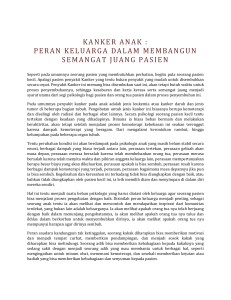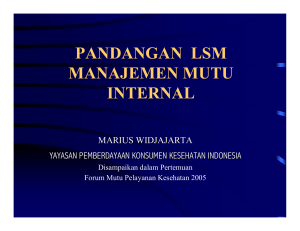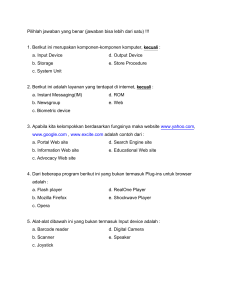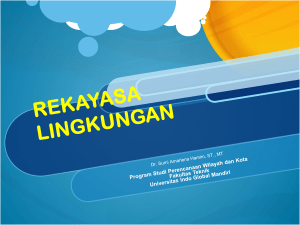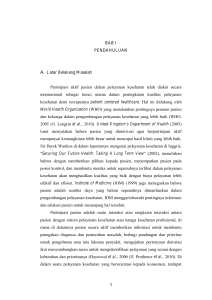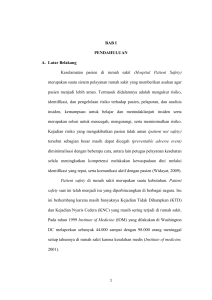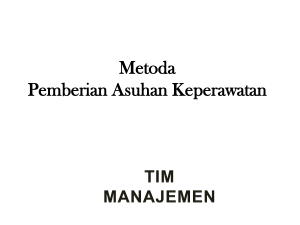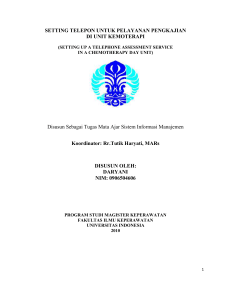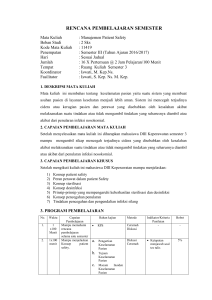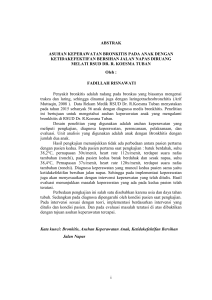Soal:
advertisement
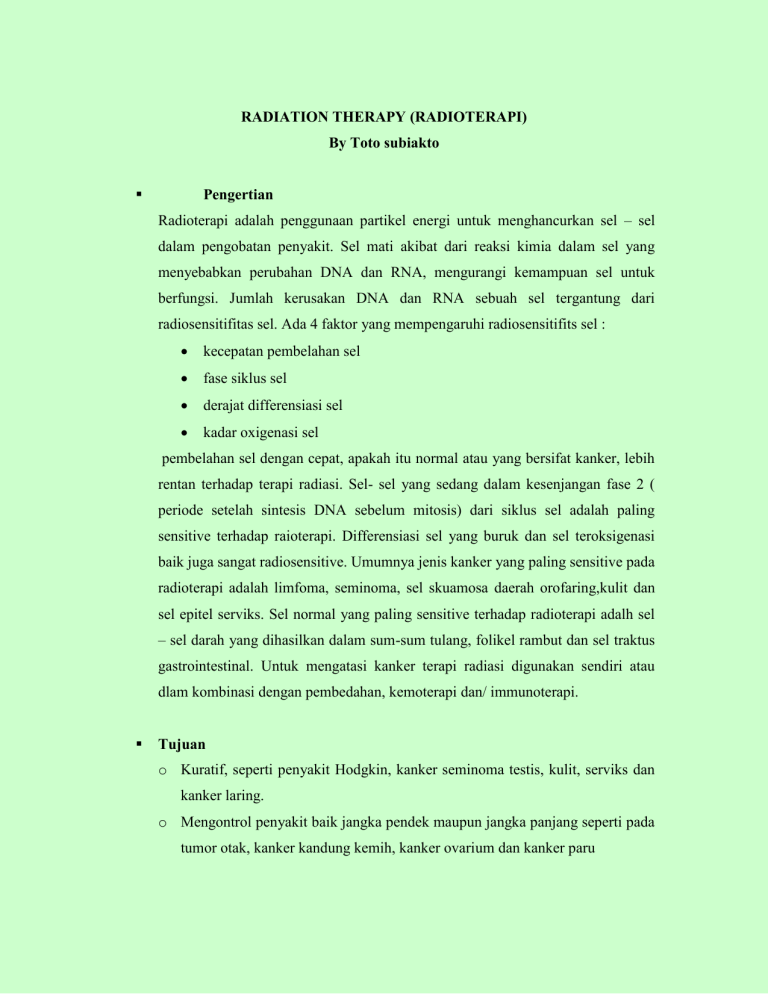
RADIATION THERAPY (RADIOTERAPI) By Toto subiakto Pengertian Radioterapi adalah penggunaan partikel energi untuk menghancurkan sel – sel dalam pengobatan penyakit. Sel mati akibat dari reaksi kimia dalam sel yang menyebabkan perubahan DNA dan RNA, mengurangi kemampuan sel untuk berfungsi. Jumlah kerusakan DNA dan RNA sebuah sel tergantung dari radiosensitifitas sel. Ada 4 faktor yang mempengaruhi radiosensitifits sel : kecepatan pembelahan sel fase siklus sel derajat differensiasi sel kadar oxigenasi sel pembelahan sel dengan cepat, apakah itu normal atau yang bersifat kanker, lebih rentan terhadap terapi radiasi. Sel- sel yang sedang dalam kesenjangan fase 2 ( periode setelah sintesis DNA sebelum mitosis) dari siklus sel adalah paling sensitive terhadap raioterapi. Differensiasi sel yang buruk dan sel teroksigenasi baik juga sangat radiosensitive. Umumnya jenis kanker yang paling sensitive pada radioterapi adalah limfoma, seminoma, sel skuamosa daerah orofaring,kulit dan sel epitel serviks. Sel normal yang paling sensitive terhadap radioterapi adalh sel – sel darah yang dihasilkan dalam sum-sum tulang, folikel rambut dan sel traktus gastrointestinal. Untuk mengatasi kanker terapi radiasi digunakan sendiri atau dlam kombinasi dengan pembedahan, kemoterapi dan/ immunoterapi. Tujuan o Kuratif, seperti penyakit Hodgkin, kanker seminoma testis, kulit, serviks dan kanker laring. o Mengontrol penyakit baik jangka pendek maupun jangka panjang seperti pada tumor otak, kanker kandung kemih, kanker ovarium dan kanker paru o Faliatif untuk meningkatkan kwalitas hidup dengan menghilangkan gejala dan mencegah komplikasi Indikasi - Kanker seminoma testis, - Kanker laring - Tumor otak - Kanker kandung kemih - kanker ovarium - kanker paru Kontraindikasi: - Eritema persiapan - talk - air yang bersih dan steril - sarung tangan - obat – obatan : Prosedur a. Sebelum melakukan tindakan Menentukan type dan jumlah radiasi yang digunakan, pengaruh serta bahayanya Memperpanjang waktu memulai radiasiterapi, perawat memperhatikan kondisi klien secara keseluruhan Perhatikan pada dinding lead atau lead aprons serta melindungi area yang terkena radioterapi Menutup area yang akan diberi terapi. Pada saat material terapi radiasi tidak digunakan maka material tersebut harus disimpan ditempat yang aman b. Jika perawat dan anggota keluarga ikut dalam prosedur radiasi maka mereka harus melindungi diri c. pada saat klien sedang mendapat radiasi , semua perawat jaga dan fasilitator harus melindungi diri d. catat berapa waktu yang dibutuhkan dan berapa material yang terpakai e. menjaga akses dan mensupport klien serta orang –orang yang ikut serta dalam terapi radiasi f. perhatikan prosedur kerja dan bersama pasien membuka segel iodine 1. Perawat memakai sarung tangan elastis ketika memberikan perawatan 2. Cuci tangan sebelum melakukan tindakan, tempat yang diisi air harus didesinfeksi 3. Cuci tangan dengan menggunakan sabun dan memakai air yang mengalir 4. Simpan semua barang- barang pasien didalam tas 5. Jelaskan pada pasien dan keluarga perlunya perlindungan terhadap radiasi ( Smith,2000) F. Respon akut terhadap Radiotherapi Kulit : kehilangan lapisan epidermis, eritema, kering, deskuamasi dan hyperpigmentasi Gastrointestinal : mukositis, proktitis, disphagia, ulcerasi, nausea, vomitus, diare, malnutrisi. Kelaenjar saliva : Penurunan pembentukan saliva, membran mukosa kering, perubahan rasa, disfagia. Ginjal : cistitis Sumsum tulang : Mielosupresi, anemia, trombositopenia Rambut : kehilangan rambut Paru-paru : pnemonitis Jantung : MCI/pericarditis Brain/spinal cord : edema Ovari/testis : amenorhoe, pengurangan produksi sperma Hal-hal yang harus diperhatikan Efek samping dapat terjadi dalam 6 bulan dirujuk sebagai efek samping akut dan yang terjadi selama 6 bulan disebut efek lanjut atau efek samping kronis. Efek samping akut yang terjadi dalam pembelahan sel kulit yang amat cepat, membrane mukosa, folikel rambut dan sum-sum tulang umumnya reversible, efek samping kronis dalam sel yang membelah secara lambat seperti sel –sel otot dan pembuluh darah yang biasanya permanent. Efek samping yang dialami pasien terbatas pada daerah yang terkena. Akan tetapi seseorang yang menerima terapi radiasi mungkin mengalami efek sistemik seperti : mual, anoreksia dan kelelahan. Gejala ini berhubungan dengan kerusakan dari sel kanker dan filtrasi sel ini dengan hasil yang melewati tubuh, secara umum kebanyakan apsien mentoleransi radioterapi dengan baik. PENGOBATAN BIOTERAPI Terapi biologis atau bioterapi muncul dengan cepat sebagai modalitas pengobatan keempat untuk kanker. Bioterapi didasarkan atas teori bahwa system imun mengenal sel tumor sebagai benda asing yang akan merusak mereka. Agen-agen yang menstimulasi system imun disebut biologic responsse modifier (BRM). BRM sebagai agent atau pengobatan yang mengubah hubungan antara respon tumor dan hospesnya pada sel-sel tumor dengan akibat efek terapeutik. Karakteristik umum BRM yaitu secara normal diproduksi tubuh dalam jumlah kecil, berfungsi sebagai pengatur dan pembawa pesan penting dari fungsi imun, mendorong respon tubuh terhadap benda asing, dan bereaksi langsung atau tidak langsung untuk menstimulasi atau meningkatkan aktivitas system imun. A. Pengertian Bioterapi yaitu pengobatan dengan agent turunan dari sumber biologic dan atau pengaruh respon biologic (Gale dan Charette. 2000). Bioterapi didefinisikan sebagai terapi dengan agen yang diambil dari sumber biologis dan atau yang mempengaruhi respon biologis. National Cancer Institut Division of Cancer Treatment menjabarkan BRM sebagai agen atau pendekatan yang memodifikasi hunbungan antara tumor dan penderita dengan memodifikasi respon biologis penderita terhadap sel tumor dengan suatu efek terapi sebagai resultannya (Otto, 1996) Zat-Zat Utama yang Digunakan Jenis BRM meliputi vaksin, antibody monoclonal, faktor stimulasi koloni (CSF), interleukin (IL), interferon (IFN). Umunya merupakan substansi alami tubuh yang bertindak sebagai pembawa pesan antar sel. Terminology generic pembawa pesan ini adalah sitokinin, yang merupakan suatu produk protein sel yang bertindak sebagai regulator. Lebih spesifik lagi limfokin, limfokin merupakan produk limfosit, dan monikin produk dari monosit. Istilah interlukin mengacu pada protein yang bertindak sebagai pebawa pesan antar sel. 1. Interferon (IFN) Interferon dapat digolongkan pada kelompok hormone glikoprotein yang memiliki efek biologis : antivirus, antiprolifeatif dan sebagai immunomodulator. Ada tiga jenis interferon yaitu Alfa, Beta dan Gama. Dalam perawatan kanker Interferon bekerja dalam beberapa cara dengan memperlambat replikasi sel, sintesa protein dan produksi DNA. Interferon akan akan memperpanjang siklus sel dan dengan menstimulasi respon imun hospes, akhirnya akan meningkatkan aktivitas pembunuhan secara alamiah. Untuk pengobatan kanker yang diijikan FDA (Food and Drug Administration) yaitu interferon Alfa (Intron_A dan Roferon A, IFN-Alfa) dijinkan untuk pengobatan leukemia sel berambut, Sarkoma Kaposi, dan hepatitis C, juga dipakai untuk melawan limfoma, melanoma dan Ca sel ginjal, Ca ovarium, Ca bladder superfisialis. Cara pemberian IFN adalah secara intramuscular dan subkutan, intravena, intralesi, intraperitoneal, intravesikal, dan intrateka. Efek samping umum adalah misalnya flu meliputi demam, menggigil, sakit kepala, nyeri otot, nyeri sendi dan keletihan. Ini biasanya diatasi dengan antipiretik dan analgetik. Efek samping lain meliputi supresi sumsum tulang, mual, muntah, diare dan perubahan status mental meliputi depresi, ansietas dan insomnia. 2. Interlukin (IL) IL adalah pembawa pesan penting dan pengatur fungsi imun. Ada dua belas jenis IL, namun yang diizinkan FDA untuk pengobatran Ca yaitu IL-2 atau interlukin-2 (Proleukin). Kerja dari IL-2, suatu limfokin meliputi : Menstimulasi proliferasi lifosit T dan B dan sel Pembunuh Alamiah (NK), meningkatkan sitoksititas dari sel mono, limfoT, dan sel NK, menginduksi sekresi antibody, yakni Faktor Nekrosis Tumor, dan IFNgamma, mengawali aktivitas produksi sel Pembunuh Limfo-Teraktivasi (LAK) Efek samping IL-2 berhubungan dengan dosis. Dosis yang lebih tinggi akan menimbulkan efek samping yang lebih besar. Efek sampig yang sering terjadi diringkas sebagai berikut : Gejala misalnya flu : demam, menggigil, kaku, keletihan, nyeri otot, sakit kepala. Kardiovaskular : potensi syndrome kapiler bocor, dehidrasi vascular, angina, infark miokardium, aritmia, edema pulmonal dan edema perifer. Ginjal : oliguri, anuria, azotemia, peningkatan kreatinin. GIT : anoreksia, mual, muntah, diare. Perubahan status mental : depresi, ansietas, psikosis, koma. Integumen : eritema, lepuh misalnya terbakar dan gatal. 3. Colony-stimulating factor /CSF) CSF termasuk kedalam kelompok hormone glikoprotein yang bertanggung jawab untuk deferensiasi proliferasi dan pematangan sel-sel hematopoetik in vitro. Ada empat kelompok CSF yaitu : CSF granulosit makrofag (GM-CSF), CSF granuliosi (G-CSF), CSF makrofag (M-CSF), dan IL-3 (multi-CSF) Hasil studi menunjukan bahwa CSF memiliki nilai klinis pada beberapa keadaan tertentu ; menurunkan mielosupresi, mempercepat penyembuhan setelah transplantasi sumsum tulang, mempertahankan susmsusm tulang pada anemia aplastik, syndrom mielodisplasia, mieloma, , leukemia dan neutropenia didapat maupun congenital. Cara pemberian agent CSF adalah sebagai berikut: GM-CSF sering diberikan IV selama 2 jam yang dimulai 2 – 4 jam setelah infuse susmum tulang autolog. G-CSF diberikan subkutan atau intravena. M-CSF diberikan subkutan. IL-3 (multi-CSF) diberikan subkutan maupun IV. Efek samping therapy dengan CSF tergantung pada dosis pemberian. Efek samping yang sering terjadi pada GM-CSF yaitu : menggigigl dan demam, nyeri tulang, kelelahan, anoreksia, ruam kulit, rasa panas pada kulit, flebitis, gangguan pencernaan, eritema pada tempat penyuntikan, , hipotensi, retensi cairan, perikarditis, efusi pleura dan pericardium. KEMOTHERAPI A. Pengertian Kemoterapi adalah penggunaan obat-obatan sitotoksik dalam terapi kanker untuk menyembuhkan, mengontrol penyakit atau sebagai terapi paliatif. Kemoterapi bersifat sistemik dan berbeda dengan terapi local seperti pembedahan dan terapi radiasi. Ada empat cara penggunaan kemoterapi : 1. Terapi adjuvant, suatu sesi kemoterapi yang digunakan sebagai tambahan dengan modalitas terapi lainnya dan ditujukan untuk mengobati mikrometastasis. 2. Kemotherapi neoadjuvan, terapi untuk mengecilkan tumor sebelum dilakukan pembedahan pengangkatan tumor 3. Terapi primer, terapi pada Ca local, alternative yang ada tidak terlalu efektif. 4. Kemoterapi induksi, obat yang diberikan sebagai terapi primer untuk pasien Ca yang tidak memiliki alternative terapi 5. Kemoterapi kombinasi, pemberian dua atau lebih zat kemoterapi dalam mengobati Ca yang bersifat sinergis. B. Dasar Pengobatan Menghentikan siklus pembelahan sel pada tahap yang spesifik utk semua sel Ca yang membelah cepat (pada hampir semua Kanker) dan menghentikan tidak pada siklus yang spesifik utk sel Ca yang membelah lambat C. Klasifikasi Obat Berdasarkan aktivitas farmakologis dan pengaruhnya terhadap reproduksi , diklasifiksaikan sebagai berikut : 1. Obat-obat spesifik fase siklus sel yang berpengaruh terhadap sel-sel yang sedang mengalami pembelahan, misalnya antimetabolit, alkaloid tanaman vinca dan zat lainnya seperti aspariganse dan dacarbazine. 2. Obat-obat fase siklus sel nonspesifik berpengaruh pada sel yang sedang membelah atau istirahat , misalnya agen alkilasi, antibiotic antitumor, nitrourea, hormone dan steroid serta agen lainnya seperti prokarbazine Agens alkilasi bekerja dengan membentuk ikatan molekelul dengan asam nukleat yang mempengaruhi duplikasi asam nukleat sehingga mencegah mitosis. Antibiotik (agen anti tumor) mengganggu traskripsi DNA dan menghambat sintesis DNA dan RNA. Antimetabolit menghambat enzim esensial yang diperlukan dalam sitesa DNA sehingga menyebabkan transmisi kode yang salah. (agen) hormone-hormon bekerja dengan memanipulasi kadar hormone yang akan mempengaruhi permiabelitas sel sehingga pertumbuhan tumor dapat ditekan. Agen anti hormonal akan menentralkan atau menghambat produksi hormone alami yang digunkan untuk pertumbuhan tumor. Nitrourea menghambat sisteis DNA dan RNA. Kortikosteroid memberikan efek antiinflamasi . Alkaloid tanaman vinca, zat ini memberikan efek sitoktosik dengan mengikat protein mikrotubular selama metaphase yang menyebabkan berhentinya mitosis dan mati. Serta agen lainnya dengan berbagai cara kerja yang dapat menghambat sistesis protein. Pemberian Kemotherapi 1. Perhitungan Dosis Obat Dosis obat yang diberikan didasarkan pada luas permukaan tubuh (body surface area/BSA) baik pada anak-anak maupun dewasa. Dosis yang diberikan bervariasi tergantung dari obat yang digunakan. Perhitungan dosis harus dipastikan oleh orang kedua. Dosis beberpa obat dihitung secara proporsional menurut luas permukaan tubuh . BSA dihitung dalam meter persegi (m2). Sebuah normogram digunakan untuk menghitung korelasi antara BB dan TB pasien untuk memnentukan LPT. Dosis obat diberikan dalam milligram per meter persegi (Otto, 1996) Contoh : TB = 170 cm, BB = 75 kg, m2 = 1,80 BSA, Dosis = 75 mg/m2. 1,80 x 75 = dosis x, maka x = 135 mg dosis. 2. Petunjuk Pemberian a. Oral, perlu penekanana mengenai kepatuhan terhadap jadwal yang telah ditetapkan. Obat-obat yang memerlukan hidrasi (sitoksa) diberikan pada pagi hari. b. Subkutan dan intramuscular, pastikan untuk mengubah tempat penyuntikan untuk setiap dosis obat y-ang diberikan. c. Topikal, lapisi daerah permukaan dengan lapisan tipis obat. d. Intraarteri, memerlukan pemasangan kateter yang terletak dekat tumor. e. Intracavitas, obat dimasukan kedalam kandung kemih melalui kateter dan atau melului selang thoraks ke dalam rongga pleura. f. Intraperitoneal, obat diberikan ke dalam rongga abdomen melalui alat dan atau dengan kateter suprapubis ekternal . hangatkan cairan infus sebelum diberikan dengan pemanasan kering. g. Intravena, dapat diberikan melalui kateter vena central atau vena perifer. Metode pemberian meliputi : 1) Bolus, pemberian obat secara langsung ke dalam vena melalui jarum. 2) Piggyback (metoda sekunder), obat diberikan menggunakan botol sekunder dan slang : infuse primer diberikan bersamaan pemberian obat 3) Sisi lengan, obat diberikan melalui spuit atau jarum pada sisi alat infuse yang sedang terpasang. 4) Infus, obat ditambahkan ke dalam botol cairan intravena yang diberikan. 3. Pemilihan Vena dan Pungsi Vena Pemilihan lokasi dan peralatan yang digunakan ditentukan oleh usia pasien, keadaan vena, obat yang digunakan dan lamanya waktu pemberian infuse. Gunakan vena bagian distal terlebih dahulu dan pilih vena diatas daerah fleksi. Pilih kateter yang terpendek dan ukuran terkecil yang sesuai dengan jenis dan lamanya pemberian infus. Vena yang digunakan biasanya yaitu vena basilica, sefalika dan metkarpal. 4. Prosedur pemberian kemoterapi Intravena Prosedur kemoterapi untuk pengobatan kanker dibawah ini juga digunakan dalam bioterapi kanker, sumber :htpp://www.krcc.on.ca. chemotherapy/iv/administration. Diakses tanggal 10 Mei 2007. adapun prosedur agent kemoterapi adalah sebagai berikut: A. Peralatan: Peralatan perlindungan personal yang sesuai : Sarung tangan dobel Pakaian kemotherapi Kapas alkohol Alas plastic absorbent disposibel Container (bengkok)untuk menampung limbah yang berbahaya (needle atau pecahan, dll) Pelindung wajah (melindungi dari percikan) Kontainer menampung limbah yang berbahaya Kemoterapi kit Peralatan untuk mencuci mata emergenci Peralatan emergenci yang mudah diakses misalnya oksigen, infuse set dengan NaCl 0,9% Anaphylaksis kit dekat tempat tidur Ektravasation kit dekat tempat tidur (jika diberikan agen vesicants) Agents (obat) dalam kantong tertutup dan tahan bocor Obat-obatan suportif Cairan IV yang sesuai. Peralatan Perlindungan Personal Tempat Pengoplosan Kemoterapi B. Prosedur Pemberian 1. Memastikan identifikasi pasien, obat, dosis, rute dan waktu pemberian sesuai dengan program therapy. 2. Mengkaji adanya riwayat alergi obat bersama pasien 3. Mengantisipasi dan merencanakan kemungkinan terjadinya efek samping atau tosiksitas sistemik 4. Memeriksa/membahas hasil pemeriksaan laboratorium dan pemeriksaan dignostik lainnya. 5. Memastikan persetujuan tindakan kemoterapi 6. Periksa peralatan yang dibutuhkan: jarum infus, set infus, tiang infus dll 7. Memilih peralatan yang sesuai 8. Menghitung dosis dan menyediakan obat dengan teknik aseptic ; mengikuti petunjuk yang ada. Cek ulang perhitungan dosis oleh perawat yang telah teregistrasi. (lihat persiapan obat) 9. Menjelaskan prosedur kepada pasien dan keluarganya 10. Persiapkan & lakukan pemasangan infus perifer atau vena sentral 11. Memberikan antiementik, antibiotik atau obat lain yang disarankan 12. Mempersiapkan lokasi pemasangan infuse atau jalur vena sentral 13. Memberikan agen kemoterapi - Gunakan peralatan pelindung - Berikan obat dengan aman tanpa terburu-buru - Letakan bantalan absorben beralas plastic dibawah slang selama pemberian obat untuk menyerap setiap tumpahan atau kebocoran. - Jangan membuang alat-alat atau obat yang tidak digunakan dekat dengan area perawatan pasien. 14. Memantau pasien sebelum, selama dan setelah pemberian kemoterapi. Monitor tanda-tanda vital setiap 20 – 30 menit pada dua jam pertama, khusussnya pada pemberian antineoplastik dengan potensial anafilaksis tinggi. 15. Membuang seluruh peralatan yang telah digunakan atau tidak terpakai dalam suatu tempat yang aman dari kebocoran dan jauh dari jangakauan pasien 16. Mencatat setiap prosedur menurut ketentuan yang berlaku. Mempersiapkan Obat Kemotherapi 1. Semua obat kemoterapi dari kemasannya yang dimasukan kedalam sebuah lemari khusus yang aman secara biologis (Biology Safety Cabinet /BSC) 2. Gunakan peralatan proteksi pribadi : sarung tangan karet yang tidak tembus, baju dan celana khusus berkaret dan tertutup di depan, masker, kaca mata pelindung mata atau pelindung wajah jika tidak menggunakan lemari khusus yang aman secara biologis. 3. Gunakan seragam lengkap 4. Lakukan pengoplosan kemoterapi diruang “Laminary Air Flow” yang menggunakan kabinet “Biosafety” • Fan dalam “Biosafety” harus selalu dalam keadaan hidup. • Aliran angin pada sistem “Biosafety” harus dari luar ke dalam box, dan dari box “Biosafety” angin dibuang keluar • Alas meja “Biosafety” harus yang dapat menyerap air. • Pengoplosan harus dibalik kaca “Biosafety” Saran untuk mengurangi pajanan, meliputi : - Cuci tangan sebelum dan sesudah menyiapkan obat - Batasi akses kedaerah penyiapan obat - Letakan penampung berlabeluntuk tumpahan obat dekat dengan area penyiapan - Gunakan sarung tangan sebelum memegang obat - Persiapkan obat dengan mnerapkan teknik aseptic - Hindari makan, minom, merokok, menggunakan kosmetik, menyimpan makanan pada atau dekat dengan area penyimpanan obat. - Letakan bantalan absorben pada daerah kerja - Buka botol atau ampul jauh dari badan - Buka botol obat menggunkan jarum filter hidrofobikatau pin untuk menghindari semburan obat. - Gosok daerah sekeliling leher botol dengan alcohol sebelum membukanya - Susun obat-obtan dalam lemari dengan standar biolodis kelas II, dengan menggunakan vial asli atau dengan kantong plastic yang memiliki perekat. - Tutup ujung jarum dengan kasa steril pada saat mengeluarkan oudara dari spuit. - Beri label setiap obat kemoterapi - Bersihkan setiap tumpahan dengan segera - Bawa obat kedaerah pengiriman dalam tempat yang anti bocor. - KEMOTERAPI DAN BIOTERAPI INTRAVENA UNTUK MENGOBATI KANKER Prinsip-Prinsip Pelaksanaan 1. Persiapan, penanganan dan pelaksanaan kemoterapi dan bioterapi agent dnan penanganan cairan tubuh pasien serta terekpose obat-obat berbahaya. 2. Metoda pemberian infuse mencakup a. Piggy-back (short term) b. Free-Flow-Pus c. Terus Menerus (Continuous) 3. Kemoterapi dipertimbangkan sebagai pengobatan dengan kewaspadaan tinggi (ISMP Canada) Peralatan: Peralatan perlindungan personal yang sesuai : Sarung tangan dobel Pakaian kemotherapi Kapas alkohol Alas plastic absorbent disposibel Container (bengkok)untuk menampung limbah yang berbahaya (needle atau pecahan, dll) Pelindung wajah (melindungi dari percikan) Kontainer menampung limbah yang berbahaya Kemoterapi kit Peralatan untuk mencuci mata emergenci Peralatan emergenci yang mudah diakses misalnya oksigen, infuse set dengan NaCl 0,9% Anaphylaksis kit dekat tempat tidur Ektravasation kit dekat tempat tidur (jika diberikan agen vesicants) Agents (obat) dalam kantong tertutup dan tahan bocor Obat-obatan suportif Cairan IV yang sesuai. Cara Kerja 1. Mengkaji status kondisi pasien dan toksisitas obat dengan alat pengkajian yang disetujui 2. Memastikan order dari medis dan persetujuan tindakan kemoterapi/bioterapi 3. Memastikan cara pemberian dan dosis bandingkan dengan pemberian terakhir 4. Mengkaji kelengkapan order meliputi terapi suportif pre dan post terapi misalnya hidrasi, antiementik 4.1 memastikan bahwa dosis sesuai untuk pasien, diagnosis dan rencana keperawatan 4.1.1 Jika ragu-ragu, konsultasikan denagn ahli pharmasi atau dokter. 5. Cek ulang dosis secara perhitungan matematis oleh perawat yang telah teregistrasi dihubungkan dengan body surface area. 6. menentukan obat-obat yang bersifat vesicant dan yang berpotensi iritan. 7. Menentukan metoda pemberian infuse ( mengacu pada chart pemberian obat-obat sitotoksisk) 7.1. Piggy-back (short term), menentukan selang infuse yang sesuai dengan larutan dan infuse piggy-back kemoterapi serta dosis yang membutuhkan selang khusus. 7.2. Free-Flow Push, dapatkan selang infuse yang sesuai dengan larutan dan hubungkan syringe yang berisi obat ke port tertutup pada pasien. 7.2.1. pemberian agent IV push, diperbolehkan larutan infuse IV untuk melarutkan obat tersebut. 7.3. Continue infusion (24 jam atau lebih) , infuse continue umunya menggunakan suatu line PICC atau alat penyabang (cagak) sebab konsentrasi obat pada infuse. Misalnya doxorubicin, fluorouracil, cisplatin) 7.4. Vesicants: 7.4.1. Hindari infuse vesicants lebih lama dari 30 – 60 menit 7.4.1.1. Pemberian infuse vesicants untuk waktu lebih dari 30- 60 menit melalui CVP 7.4.2 Jangan menggunakan infuse IV perifer untuk pemberian vesicants secara continue. 8. Prioritaskan segera untuk mengantungan infuse dengan benar 8.1. Identifikasi dua identitas spesifik pasien (misalnya nama dan tanggal lahir) 8.2. PPengembalian darah dan kepatenan IV 8.2.1. Kepatenan vena dan pembilasan dilakukan dengan menggunakan minimal 10 ml larutan IV yang sesuai antara pemberian setiap agent baru. 9. Sebelum, selama dan setelah infuse, monitor tanda-tanda vital setiap 20 – 30 menit pada dua jam pertama, khusussnya pada pemberian antineoplastik dengan potensial anafilaksis tinggi. 10. Untuk pemberian Vesicants 10.1. Fundamentals of Administration A. Pretreatment Follow institutional guidelines regarding documentation of assessment and provision of care. Appendices 1 and 2 in the original guideline document provide sample flow sheets. Nursing assessment and case review Patient history Review recent treatment(s), including surgery, radiation therapy, prior cytotoxic therapy, hormonal therapy, and complementary therapies (e.g., acupuncture, chiropractic, nutritional). Review and document medical, psychiatric, and nononcologic surgical history. Document drug, food, and environmental allergies. Obtain an accurate list of all medications that the patient uses, including prescription, over-the-counter, herbs, and vitamins. More than 40% of the American public use complementary and alternative medicine. Patients may disclose use of these products only when directly questioned in a nonjudgmental fashion (Oliveira, 2001; Reuters Health, 2000). Age-specific concerns: The elderly often have multiple comorbidities for which they take multiple medications. Be aware of the potential for drug interactions with chemotherapy agents (Hood, 2003). Signs and symptoms of underlying disease process and any previous treatments Symptom screening during the pretreatment phase is crucial to successful symptom management. Poorly controlled symptoms impact the quality of life for the patient and can interfere with delivery of chemotherapy and other treatment modalities (Dodd, Miaskowski, & Paul, 2001; Houldin, 2000). Screening tools Assess performance status by using scales such as the Karnofsky, Zubrod, or Eastern Cooperative Oncology Group (see Table 3 in the original guideline document). Assess pain using an age-appropriate scale (e.g., numeric 0–10 scale, facial expressions, visual analog). Assess for fatigue using an appropriate scale, such as the Brief Fatigue Inventory (Mendoza et al., 1999), the Piper Fatigue Scale (Piper et al.,1998), or the Schwartz Cancer Fatigue Scale (Schwartz, 1998). Patient data Obtain and document the patient's actual height and weight; compare with previous visits. Compare current and previous lab values. Age-specific concern: Assess for age related changes in pulmonary, renal, and cardiac function in the elderly. Review diagnoses, tumor type, grade, and staging. Obtain treatment records from past encounters to determine symptom management strategies that were employed. Assess cultural and spiritual issues that may affect the treatment plan. Assess how the patient and family are coping with the cancer experience. Determine the need for referral to a social worker, spiritual care provider, dietitian, physical therapist, and other member of the multidisciplinary team as needed. Age-specific concerns: When caring for pediatric patients, consult play therapists and child-life specialists. If a school-age youth is going to be out of school for a prolonged time, explore options for continued study available through the appropriate school district (e.g., home study, online programs). Information and learning needs of patient and family (Houldin, 2000) Determine the preferred language. Assess speaking fluency and reading literacy. Assess level of understanding of the disease and treatment. Identify the patient's preferred learning style. Provide information regarding Drugs, side effects, and symptom management When and how to call the nurse and/or doctor Follow-up care and labs How to access support services. Treatment plan (Santell, Protzel, & Cousins, 2004) Read the written orders in their entirety, then scrutinize each line for Name of drug ordered Drug dose Method of determining dose Route of administration Rate of administration Frequency and/or date(s) of administration Premedications Hydration, if applicable Protocol or reference Assess orders for completeness (e.g., hydration, premedications). Review the patient's actual height and weight; double-check the patient's BSA. Have two individuals independently recalculate the drug dose and compare to the ordered dose (American Society of Health-System Pharmacists [ASHP], 2002). Follow institutional policy for who can double check doses (e.g., two registered nurses (RNs), RN and pharmacist). Verify that the dose is appropriate for the patient, diagnosis, and treatment plan. If in doubt, clarify. Consult a pharmacist and/or physician. Determine the vesicant and irritant potential of the drug(s). Follow institutional policy regarding obtaining consent. Assess the patient's prior experience with cytotoxic therapy (e.g., adequacy of symptom management, delayed side effects, willingness to proceed). Immediately before administration, verify the order, the drug names, calculations, expiration dates and times, appearance of the drugs, and accuracy of two different patient identifiers (Joint Commission on Accreditation of Healthcare Organizations [JCAHO], 2004). Treatment Patient preparation Explain to the patient and family/caregivers who will administer the chemotherapy, the route, and the planned sequence of events. Describe the plan for symptom management. Provide information regarding (Vandegrift, 2001) Premedications Hydration Intake and output assessment Laboratory monitoring Diet during chemotherapy Potential side effects of chemotherapeutic and adjunct medications Baseline vital signs as indicated. Staff preparation Review all physician orders. Have a spill kit, extravasation equipment, and emergency drugs/equipment available as needed (Otto, 2004). Age-specific concerns: If administering chemotherapy to a child, patientspecific dosing information and emergency equipment must be available. Calculate emergency drug doses before they are needed. Obtain monitoring equipment as indicated. Obtain infusion pumps and other devices as needed. Age-specific concerns: Use a volumetric pump to administer chemotherapy to pediatric patients (Frey, 2001; Infusion Nurses Society [INS], 2000). Routes of administration Oral: The role of oral chemotherapy agents is expanding, with many new drugs in development, reflecting a new paradigm in which cancer is treated as a chronic disease with long-term management (Bedell, 2003). Advantages Ease and portability of administration Increased sense of patient independence Disadvantages Inconsistency of absorption Potential loss of drug in the event of emesis Potential for drug/herb/diet interactions Issue of medication adherence Cost/reimbursement concerns (Birner, 2003) Potential complications Drug-specific Related to drug-drug interactions Related to swallowing difficulties Nursing implications Age-specific concerns: Young children may require liquid preparations. For elderly patients, evaluate ability to swallow pills intact, plus ability to selfmanage medication regimen (Hartigan, 2000). Patient education is key to promoting medication regimen adherence. Provide verbal and written instructions, including name of the medication, dose/schedule, how taken, and safety (storage and handling). a. Subcutaneous (SQ) or Intramuscular (IM) injection (see Table 12 in the original guideline document for maximum volumes for intramuscular injections for children) (Camp-Sorrell, 2004; Goodman, 2000) 1. Advantages a. Ease of administration b. Decreased side effects 2. Disadvantages a. Inconsistency of absorption b. Requires adequate muscle mass and tissue for absorption 2. Potential complications a. Pain/discomfort b. Infection c. Bleeding 3. Nursing implications a. Monitor platelet count and ANC. b. Use smallest needle possible; some solutions may come with pre-prepared syringes (follow manufacturer's instructions). c. Follow institutional policy for site antisepsis and documentation. d. Assess previous injection sites for signs and symptoms of infection or bleeding. b. Intra-arterial: Delivers medication directly into an organ (e.g., brain, liver, head and neck, pelvis) or tumor by means of three types of access devices. Refer to the Oncology Nursing Society (ONS) Access Device Guidelines and Recommendations for Practice (Camp-Sorrell, 2004) for more detailed information. 4. Types of devices a. Short-term percutaneous catheters inserted via femoral or brachial artery (frequently placed by interventional radiologists) b. Long-term catheters placed during surgery and used as an external catheter or attached to an implanted pump c. Implanted ports for long-term therapy 5. Advantages a. Increased exposure of tumor to drug results in greater tumor response with less systemic side effects. b. This therapy is considered a local treatment, as the drug's first major site of action is the target lesion, thereby avoiding the first pass effect. 2. Disadvantages a. Less systemic circulation of the chemotherapy increases the risk for distant metastasis. b. Requires surgical procedure or special radiography equipment for catheter or port placement. c. Requires specialized nursing education for arterial pumps. d. When treatment is given by percutaneous catheter, the patient may have sharply limited mobility for three to seven days. 3. Potential complications a. Bleeding b. Embolism c. Pain d. Pump occlusion or malfunction e. Hepatic artery injury f. Arterial catheter leak or break g. Skin reaction to tape or dressing h. Catheter migration/dislodgment 4. Nursing implications a. Monitor for signs/symptoms of bleeding, including monitoring prothrombin time (PT)/partial thromboplastin time (PTT). b. Monitor catheter site for infection, bleeding, signs of catheter migration/dislodgment, including epigastric pain, nausea/vomiting/diarrhea, edema, diminished peripheral pulse, and inability to infuse. c. Monitor for signs of occlusion, including inability to flush or withdraw fluid, abdominal pain, or change in color/pulse/temperature of involved extremity. If patient is going home with infusion, provide patient education regarding pump and catheter care. Follow pump manufacturer's recommendations for implanted pumps (Barber & Fabugais-Nazario, 2003; Hagle, 2003). c. Intrathecal/intraventricular (Camp-Sorrell, 2004; Gullatte, 2001) 1. Advantages a. Affords more consistent drug levels in cerebrospinal fluid b. Bypasses the blood-brain barrier c. Also can be used to sample cerebrospinal fluid and to administer opiates and antibiotics 2. Disadvantages a. Requires lumbar puncture or surgical placement of implanted intraventricular device (e.g., Ommaya reservoir) b. Generally requires a physician or specially trained registered nurse to access and administer chemotherapy via this route 3. Potential complications: Increased intracranial pressure, headaches, confusion, lethargy, nausea and vomiting, seizures, and infection 4. Nursing implications a. Observe site for signs of infection. b. Assess patient for headache or other signs of increased intracranial pressure (Kosier & Minkler, 1999). c. Accessing the Ommaya reservoir is a sterile procedure. Medication to be instilled must be preservative free. d. Do not use a Vacutainer® (Beckton Dickinson & Co., Franklin Lakes, NJ) to withdraw cerebrospinal fluid (CSF): Rapid withdrawal of fluid could damage the choroids plexus of the ventricle. Avoid air embolism. d. Intraperitoneal (Camp-Sorrell, 2004; Goodman, 2000). 4. Advantages a. Provides direct exposure of intra-abdominal metastases to the drug(s) b. Also may instill radioactive or colloid materials intraperitoneally 5. Disadvantages: Requires placement of a peritoneal catheter or intraperitoneal port 6. Potential complications a. Abdominal pain b. Distention c. Bleeding d. Ileus e. Intestinal perforation f. Infection 7. Nursing implications a. Warm chemotherapy to body temperature (Otto, 2004). b. Check patency of catheter or port according to institutional policy. c. Instill solution according to protocol: Infuse drug, reposition patient for maximum surface exposure to drug, and drain if ordered. e. Intrapleural: Instills sclerosing agents such as nitrogen mustard, bleomycin, or 5-fluorouracil (5-FU), or sterile talc into the pleural space (Goodman, 2000); also may instill radioactive colloidal materials 2. Advantage: Scleroses the pleural lining to prevent recurrence of effusions 3. Disadvantages a. Requires insertion of a thoracotomy tube b. Physicians must administer the intrapleural agents. 3. Potential complications a. Pain b. Infection 4. Nursing implications a. The effusion must be completely drained from the pleural cavity before instillation of the drug (thoracentesis). b. Following instillation, clamp the tubing and reposition the patient every 10-15 minutes for two hours, or as ordered (Otto, 2004). c. Assess for and treat pain and anxiety. f. Intravesicular (Goodman, 2000) 2. Advantage: Provides direct exposure of superficial, localized cancers of the bladder surfaces to drugs, such as thiotepa, mitomycin, epirubicin, doxorubicin, and mitoxantrone 3. Disadvantages: Requires placement of a Foley catheter 4. Potential complications a. Urinary tract infection b. Cystitis c. Bladder contracture d. Urinary urgency 4. Nursing implications a. Maintain sterile technique during Foley insertion. b. Follow physician orders or protocol for schedule of repositioning the patient and clamping and unclamping the catheter after instilling the chemotherapy. f. IV (Camp-Sorrell, 2004; Goodman, 2000) 1. Advantages a. Consistent absorption b. Required for vesicant and many other agents 3. Disadvantages a. Requires considerable nursing and patient time in a healthcare facility b. Interferes with patient's activities; sclerosing of veins over time c. May require surgical procedure for central line placement 4. Potential complications a. Infection b. Phlebitis c. Infiltration d. Extravasation (INS, 2000) e. Local discomfort f. Drug-specific concerns 5. Nursing implications will be discussed in the following section. 3. IV cytotoxic administration: Most cytotoxic agents are given intravenously. Refer to Access Device Guidelines: Recommendations for Nursing Practice and Education (Camp-Sorrell, 2004) for a complete discussion of obtaining IV access. a. Peripheral IV access 4. Existing IV site a. Avoid using a site that is more than 24 hours old. b. Assess the insertion site for signs of inflammation and infiltration, and consider the patient's statements about comfort. Use another access site if there is any doubt about the integrity of the IV site. c. Assess blood return and patency. 5. New IV site: Avoid use of steel needles for vesicant administration (O'Grady et al., 2002). Select the smallest gauge and shortest length catheter to accommodate the prescribed therapy (INS, 2000). Consider use of dermal anesthesia to minimize pain during IV insertion. a. In adults (Camp-Sorrell, 2004; Goodman, 2000) i. Identify an appropriate IV site by assessing the patient's arms carefully. Veins of choice are smooth and pliable; the large veins of the forearm are preferred. ii. Avoid establishing an IV site in the following. Injured or sclerosed veins Areas of flexion Small, fragile, tortuous veins An extremity with altered venous return or lymphedema An extremity with decreased sensation or paresthesia The lower extremities iii. Perform venipuncture per institutional policy and procedure. iv. Establish blood return and patency. v. Secure the IV device appropriately, in a manner that allows a clear view of the site. vi. If venipuncture is unsuccessful, utilize the opposite arm for the next attempt. If it is not possible to use the opposite arm, select a site proximal to the first venipuncture. b. In children, select an appropriate site, following institutional policies and the guidelines that follow (Hankins, Lonsway, Hedrick, & Perdue, 2001). i. If possible, do not use the feet or dominant hand of an infant or toddler as an IV site. ii. The veins of the scalp of a child younger than 12 months old can be used as an IV site; however, do not use a scalp vein to administer a vesicant. iii. Stabilize the extremity, if necessary, while inserting and securing the IV. b. Central venous catheters (CVCs): CVCs include percutaneous subclavian catheters, tunneled subclavian catheters, and peripherally inserted central catheters (PICCs). (A midline catheter is considered a peripheral line because it ends in the middle of the upper arm.) An implanted port, although technically a CVC, is unique and will be addressed later. Note: Most CVCs require the use of syringes larger than 10 cc to minimize pressure (pounds per square inch [psi]) on delicate catheter walls (Camp-Sorrell, 2004). Follow manufacturer's and institutional guidelines carefully to avoid catheter rupture. After CVC insertion and before administering the agent, perform the following. 4. Verify that the catheter's placement is correct prior to initial use per institutional guidelines. 5. Inspect exit site for evidence of erythema, swelling, drainage, and leakage. 6. Inspect ipsilateral chest for signs of venous thrombosis (Mayo & Pearson, 1995). 7. Aspirate the line to verify blood return. If blood return is not evident, a. Flush the catheter with saline, gently using the push-pull method. b. Reposition the patient as appropriate. c. Ask the patient to cough. d. Explain to the patient why delaying therapy is necessary. Although patients may report that lack of blood return from their catheter is common, do not administer cytotoxic therapy. e. Obtain a physician's order for a declotting procedure; follow institutional protocol. f. Use x-rays or dye studies to confirm proper CVC placement and rule out catheter malfunction or migration in the absence of a blood return. c. Implanted ports: Implanted ports are available that allow venous, peritoneal, arterial, and epidural access. Ascertain which type is being used. Some patients have more than one type. 1. Assess initial line placement by using the results of x-ray or fluoroscopic dye studies. 2. Choose a noncoring needle (Goodman, 2000) with a length that is appropriate to the a. Depth of the port b. Size of the patient (i.e., the amount of SQ tissue or fat located above the port). 2. Prepare the patient's skin according to institutional policy. 3. Access the port, ensuring proper placement of the needle in the reservoir. 4. Establish blood return and patency. If blood return is not evident, repeat steps listed for CVCs. (Blood return is not expected with epidural or peritoneal access devices.) 5. Inspect the needle insertion site for needle dislodgment, leakage of IV fluid, drainage, or edema. 6. Examine the ipsilateral chest for venous thrombosis. 7. Apply an occlusive dressing to stabilize the needle. The dressing should be transparent, to allow a clear view of the insertion site. Experts disagree about other dressing characteristics that are desirable (Camp-Sorrell, 2004). When working with children, padding the undersides of the butterfly wings of the access needle may be necessary if the needle does not lie securely on the skin. d. Piggy-back or short-term infusion 1. Verify blood return and IV patency prior to hanging the infusion. Do not pinch the IV catheter to determine blood 2. 3. 4. 5. return because of the resulting dramatic change in pressure within the vein. Preferred methods of verifying patency are the following. a. Use a syringe inserted at the injection port closest to the patient to gently aspirate the line, while pinching off fluid from the bag. b. Use a gravity check by removing the bag from the pump, lowering it below the patient's IV site, and watch for blood return. Attach the secondary tubing to the appropriate injection port, using a needleless, Luer lock connector (INS, 2000). Initiate flow rate according to the physician's orders and observe the patient closely for any reactions. When administering a vesicant drug by short infusion using a peripheral vein, b. Avoid using an IV pump in order to decrease pressure on the veins. c. Monitor the site for signs of extravasation every 510 minutes for infusions less than 30 minutes. If an infusion is longer than 30 minutes, check blood return every 10-20 minutes. d. Avoid infusing vesicant agents peripherally for more than 30-60 minutes. Once the short infusion is complete, check vein patency and flush the line with a compatible IV solution. a. Continuous infusion i. Follow guidelines for checking blood return and IV patency. ii. The cytotoxic agent may be connected directly to the IV catheter, or into a compatible line of maintenance solution, according to institutional policy. iii. Secure all connections with locking devices. iv. Monitor the IV site throughout the infusion according to institutional policy and procedure. Monitor the patient closely for any reactions, such as signs or symptoms of hypersensitivity (Otto, 2004). Age-specific concerns: For pediatric patients with continuous infusions, monitor the IV site hourly or according to institutional policy (Shutak, 2000). v. When administering a vesicant, (Chu & DeVita, 2005; Vandergrift, 2001) DO NOT use a peripheral IV site for continuous vesicant administration. Use a central venous access catheter or implanted access device to administer any vesicant infusing for longer than 30-60 minutes. Check for blood return and patency periodically, according to institutional policy. vi. Once the infusion is complete, check vein patency and flush the line with a compatible IV solution (Otto, 2004). b. IV push: Refer to physician orders and/or pharmacy guidelines for suggested IV push rates, diluents, and other drug-specific details (Goodman, 2000; Vandergrift, 2001). i. Free-flow method (side-arm technique) Attach the syringe with the drug at the injection port closest to the patient. Aspirate the line in order to verify IV patency. Allow IV solution to flow freely. Slowly administer the chemotherapy agent as an IV push, allowing the flush solution to dilute the drug. Unless otherwise indicated, administer the agent at a rate of 1-2 ml/minute. When administering a vesicant, verify blood return every 2-5 ml. Once the IV push is completed, check vein patency and flush the line with a compatible IV solution. ii. Direct push method: Some institutions may require that certain cytotoxic agents be administered as an IV push directly into the IV device (Goodman, 2000; Temple & Poniatowski, 2005; Vandergrift, 2001). Select an appropriate vein and prep the skin according to policy. Establish a patent IV, flushing the new line with sterile IV solution (typically normal saline [NS] or 5% dextrose in water [D5W]) Verify blood return by aspirating the line gently. Detach the flush syringe, and attach the syringe containing the cytotoxic agent. Maintain sterile technique and minimize blood loss. Slowly administer the agent, aspirating for blood return every 2-5 ml. Upon completion of the IV push, disconnect the cytotoxic syringe. Avoid blood loss; the blood will contain the cytotoxic agent. Connect a syringe containing sterile flush solution; gently flush the catheter. Cap or discontinue the IV access device, as indicated. 4. Prosedur Pemberian Obat Kemotherapi Memastikan identitas pasien, obat, dosis, rute dan waktu pemberian sesuai petunjuk dokter Kaji riwayat obat Mengatisipasi dan merencanakan kemungkinan terjadinya efek samping atau toksiksitas sistemik. Membahas data laboratorium dan pemeriksaan lainnya Memastikan persetujuan tindakan untuk terapi Memilih peralatan yang sesuai Terdapat tiga golongan besar B. Tujuam C. Indikasi dan Kontraindikasi 1. 2. 3. 4. 5. 6. 7. pengertian tujuan indikasi/kontra indikasi persiapan : alat, lingk,pasien prosedur kerja hal – hal yang perlu diperhatikan/ kritikal thinking daftar literatur Referensi Gale.D & Charette.J (2000) ; Rencana asuhan keperawatan oncology : alih bahasa I Made Kariasa .SKp , EGC, Jakarta. Smith.S, Duell.d & Martin.B ( 2000) ; Clinical Nursing Skills Basic To Advance Skills: Third Edition . United Stated of America Baggott.C.R, Kelly.K.P, Fochtman.D. & Folley.G.V. (2002) Nursing Care of Children and Adolescents With Cancer. Third Edition. WB. Sounder Company. Philadephia, Pennsylvania
